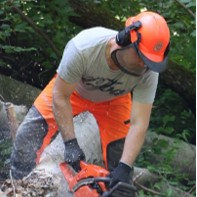Dendrochronology beyond the Ordinary: Understanding the Wood Formation and Climate Change
A special issue of Forests (ISSN 1999-4907). This special issue belongs to the section "Forest Meteorology and Climate Change".
Deadline for manuscript submissions: 31 May 2024 | Viewed by 1912
Special Issue Editors
Interests: wood and phloem formation; intra-annual density fluctuation; functional wood traits; quantitative wood anatomy; drought response; mediterranean ecosystems; scanning electron microscopy
Special Issues, Collections and Topics in MDPI journals
Interests: wood anatomy; properties; wood use; archaeological wood; cultural heritage; rare species; invasive species; innovative products; wood products
Special Issues, Collections and Topics in MDPI journals
Interests: functional anatomical traits; plant hydraulics; quantitative wood anatomy; dendro-sciences; xylogenesis; intra-annual density fluctuations; plant morpho-functional adaptation in natural environments and in crop production; plant adaptation to extreme environments
Special Issues, Collections and Topics in MDPI journals
Special Issue Information
Dear Colleagues,
Dendrochronology is a powerful tool that allows us to "travel" through time, providing insight into the past through the information stored in the growth rings. These rings encode the history of the world and provide information about ancient climates, environmental changes, and key events. Beyond retrospection, dendrochronology plays a central role in providing functional information to decipher how plant species, especially trees, adapt to environmental changes and predict future ecosystem dynamics in changing environmental scenarios. Xylogenesis, the intricate process of wood formation, is the fundamental substrate that underpins this chronology and gives it precision and authenticity. Through xylogenesis, dendrochronology bridges the temporal divide and provides a deeper scientific understanding of our ever-changing world. We are pleased to invite you to contribute to the Special Issue “Dendrochronology Beyond the Ordinary: Understanding the Wood Formation and Climate Change”.
The primary purpose of this Special Issue is to gather the necessary fuel, in the form of data, to enhance our efforts in advancing dendrochronology and its applications. These data are not limited to dendrochronology and xylogenesis but also encompass the broader area of anatomical responses of wood to the environment. The multifaceted knowledge that we are collecting will serve as the engine for our time travel and aid our research aiming to advance dendrochronology and its wide-ranging applications.
We look forward to receiving your contributions.
Dr. Angela Balzano
Dr. Maks Merela
Prof. Dr. Veronica De Micco
Guest Editors
Manuscript Submission Information
Manuscripts should be submitted online at www.mdpi.com by registering and logging in to this website. Once you are registered, click here to go to the submission form. Manuscripts can be submitted until the deadline. All submissions that pass pre-check are peer-reviewed. Accepted papers will be published continuously in the journal (as soon as accepted) and will be listed together on the special issue website. Research articles, review articles as well as short communications are invited. For planned papers, a title and short abstract (about 100 words) can be sent to the Editorial Office for announcement on this website.
Submitted manuscripts should not have been published previously, nor be under consideration for publication elsewhere (except conference proceedings papers). All manuscripts are thoroughly refereed through a single-blind peer-review process. A guide for authors and other relevant information for submission of manuscripts is available on the Instructions for Authors page. Forests is an international peer-reviewed open access monthly journal published by MDPI.
Please visit the Instructions for Authors page before submitting a manuscript. The Article Processing Charge (APC) for publication in this open access journal is 2600 CHF (Swiss Francs). Submitted papers should be well formatted and use good English. Authors may use MDPI's English editing service prior to publication or during author revisions.
Keywords
- dendrochronology
- xylogenesis
- phloem formation
- wood anatomy
- functional anatomical traits
- quantitative wood anatomy
- trees’ environmental response
- climate change







